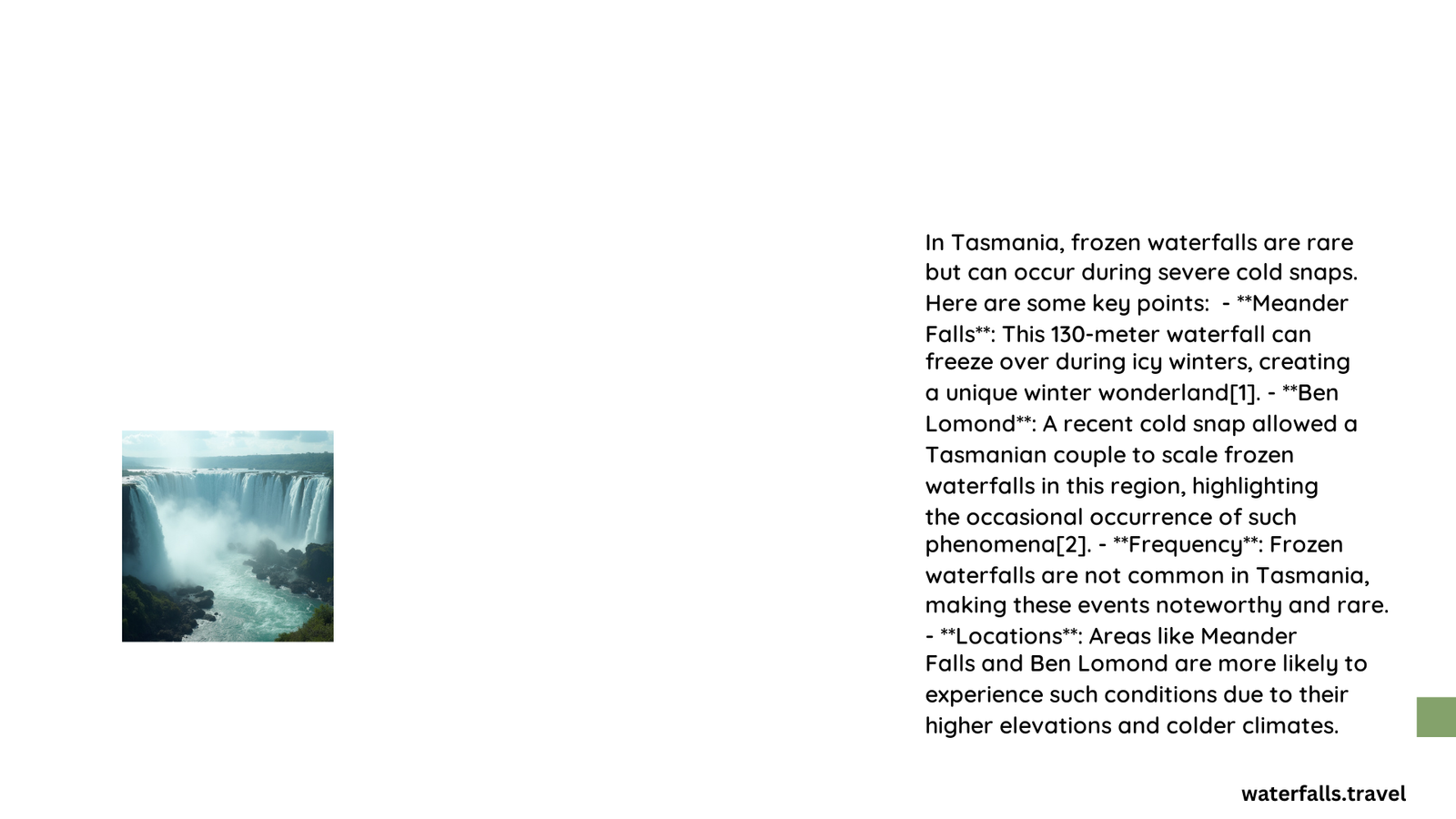Tasmania, known for its breathtaking natural beauty, offers a unique winter spectacle with its waterfalls. While true frozen waterfalls are rare due to the island’s climate, the cooler months transform these cascades into stunning displays of icy wonder. This guide explores the best locations, optimal viewing times, and photography tips for experiencing Tasmania’s winter waterfall magic.
What Are the Best Locations for Frozen Waterfall Tasmania?
Tasmania boasts numerous waterfalls that, while not completely frozen, offer spectacular winter views. Here are the top locations:
- Montezuma Falls
- Location: Williamsford, 2 km south of Rosebery
- Height: 104 meters
- Trail: 11 km round-trip, moderate difficulty
-
Winter highlight: Misty cascades with icy fringes
-
Russell Falls
- Location: Mt Field National Park
- Height: 58 meters (multi-tiered)
- Trail: Easy, wheelchair-accessible
-
Winter highlight: Frosty surroundings and increased water flow
-
Philosopher Falls
- Location: Tarkine Rainforest
- Height: 15 meters
- Trail: 3 km return, easy
- Winter highlight: Ethereal mist and occasional ice formations
When Is the Best Time to See Frozen Waterfall Tasmania?

The optimal time to witness Tasmania’s waterfalls in their winter glory is during the coldest months:
- Peak season: June to August
- Temperature range: 4°C to 12°C (39°F to 54°F)
- Best months: July and August for maximum water flow and coldest temperatures
| Month | Average Temperature | Rainfall |
|---|---|---|
| June | 6°C – 12°C | High |
| July | 4°C – 11°C | Highest |
| August | 5°C – 12°C | High |
How to Prepare for Frozen Waterfall Tasmania Hikes?
Proper preparation is crucial for enjoying Tasmania’s winter waterfalls:
- Clothing:
- Waterproof jacket and pants
- Thermal layers
- Warm hat and gloves
-
Sturdy, waterproof hiking boots
-
Equipment:
- Trekking poles for icy paths
- Thermos with hot beverages
- First aid kit
-
Navigation tools (map, compass, GPS)
-
Safety precautions:
- Check weather forecasts before departing
- Inform someone of your hiking plans
- Carry emergency communication device
What Are the Best Photography Tips for Frozen Waterfall Tasmania?
Capturing the beauty of Tasmania’s winter waterfalls requires specific techniques:
- Equipment:
- DSLR or mirrorless camera
- Wide-angle lens (16-35mm recommended)
- Sturdy tripod
-
Neutral density filters
-
Camera settings:
- Use a slow shutter speed (1/15 to 30 seconds)
- Set aperture to f/8 – f/11 for depth of field
-
Keep ISO low (100-400) for minimal noise
-
Composition tips:
- Include foreground elements for depth
- Use leading lines to guide the viewer’s eye
- Experiment with vertical and horizontal orientations
How Accessible Are Frozen Waterfall Tasmania Locations?
Accessibility varies among Tasmania’s winter waterfall locations:
- Montezuma Falls:
- Moderate difficulty
- 11 km round-trip hike
-
Well-maintained trail, but can be slippery in winter
-
Russell Falls:
- Easy accessibility
- Wheelchair-friendly path
-
Short walk from parking area
-
Philosopher Falls:
- Easy to moderate difficulty
- 3 km return hike
- Some steep sections and stairs
What Wildlife Can Be Seen Near Frozen Waterfall Tasmania?
Winter waterfall hikes offer opportunities for wildlife spotting:
- Platypus in streams and pools
- Tasmanian devils (nocturnal, rarely seen)
- Pademelons and wallabies
- Various bird species (e.g., pink robins, currawongs)
Are There Guided Tours for Frozen Waterfall Tasmania?
Several tour operators offer guided experiences:
- Tasmanian Expeditions:
- Multi-day hiking tours including waterfall visits
-
Expert guides and all-inclusive packages
-
Cradle Mountain Canyons:
- Winter canyoning adventures
-
Combines waterfall exploration with adrenaline activities
-
Pepper Bush Adventures:
- Customized tours focusing on nature and wildlife
- Can include waterfall visits upon request
What Are the Conservation Efforts for Frozen Waterfall Tasmania?
Tasmania’s waterfalls are protected through various initiatives:
- Parks and Wildlife Service Tasmania:
- Manages national parks and reserves
- Maintains trails and facilities
-
Conducts ecological monitoring
-
Tasmanian Land Conservancy:
- Acquires and protects land with significant natural values
-
Conducts research on ecosystem health
-
Waterfall conservation guidelines:
- Stay on marked trails
- Do not remove plants or rocks
- Practice ‘Leave No Trace’ principles
By following these guidelines and supporting conservation efforts, visitors can help preserve Tasmania’s stunning waterfalls for future generations to enjoy.
References:
1. How to Visit Montezuma Falls: Tasmania’s Tallest Waterfall – We Seek Travel
2. 26 Incredible Waterfalls in Tasmania With Map – We Seek Travel
3. Ice Trib Falls – Waterfalls of Tasmania
